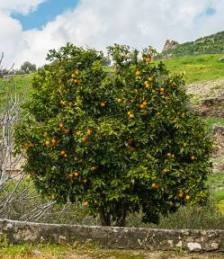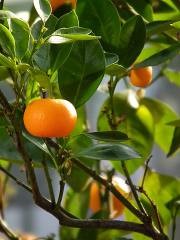Mandarin
Scientific Name: Citrus reticulata, Citrus unshu, Citrus reshni
Climate: Hot
Plant Description: The mandarin is a small, thorny tree that is more resistant to the cold than orange trees. It is a tree that adapts perfectly to desert, semi-tropical and subtropical climatic conditions.
Mandarin is a hybrid of at least two species, the Citrus reticulata and Citrus unshiu which corresponds to the Satsumas mandarin group. There are also numerous hybrids of oranges and mandarins whose generic name is mandarin.
Many mandarins tend to alternate, i.e. small fruit crops with abundant fruit are followed by small fruit crops of low quality. There are mandarins with or without seeds, in this last case the fruits are usually smaller than those with seeds.
Cultivation: It can be sown by seed, although it takes a long time to germinate and grow. Therefore it is ideal to transplant a sapling or graft a shield or bud.
It is recommended that the soil be deep to ensure the anchoring of the tree and absorption of nutrients. It requires permeable and low limestone soils. In addition, it needs humidity in the environment and in the ground.
Conditions: This tree needs to be planted in the sun. The mandarin requires large amounts of water. Watering during the first weeks should take place every 2-3 days. After 3 months of age, abundant watering every 7-10 days. All weeds and grass grasses must be completely removed within the ring around the tree, as the developing mandarin cannot compete well with them.
Mandarine is more resistant to cold and tolerates more drought than orange. But the fruits are very sensitive. Tolerates the temperature up to 3 C.
Due to its high demand for micronutrients and macronutrients we must pay special attention to magnesium and zinc deficiencies, which can be treated with foliar applications and 1% zinc sulphate. Iron deficiency should also be avoided.
It is important not to start fertilizing until the second sprouting from the date of planting.
 Uses1: The properties of mandarine peel oil have useful effects on disinfecting wounds, purifying blood, and helping in growth. At the same time it can be used in house cleaning.
Uses1: The properties of mandarine peel oil have useful effects on disinfecting wounds, purifying blood, and helping in growth. At the same time it can be used in house cleaning.
Fresh mandarin is low in calories. It is also a good source of fiber, potassium and vitamin C, which strengthens the immune system and may help protect against cancer. Mandarin also contains folate, a B-complex vitamin that is related to health during pregnancy. It is a good fruit to eat to stay healthy, and is great to use for flavoring cooking. It can be preserved into marmalade.
Pests and Diseases: Fungi - brown spots on the bundle of leaves with a white-grayish dust on the underside; root system rot, weakening and, in severe cases, death. To treat it use natural fungicides - boil cinnamon with water and let it stand overnight, then fumigate the affected area. Another way is to cover the soil around the trunk with cinnamon powder, especially when the fungus is present in the roots. Sodium bicarbonate can also be used. Mix a tablespoon of baking soda with natural soap and add a liter of water. Once the mixture is well dissolved, it can be applied to the leaves of the tree with a sprayer. Pests - red spider. Remedy - 3 ml neem oil mixed with 1 liter of water. Cochineal - 35gr of diatomaceous earth mixed with a liter of water. Whitefly - place the yellow adhesive traps. Citrus miner - 3 to 5 ml of neem oil per 1 liter of water.2
References:
- https://www.frutas-hortalizas.com/Frutas/Efectos-saludables-Mandarina.htmlhttps://www.cultivariable.com/instructions/andean-roots-tubers/how-to-grow-achira/#perennial
- https://www.jardineriaon.com/enfermedades-y-plagas-del-mandarino.html
En español: Mandarina

